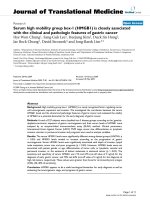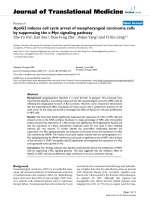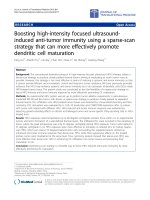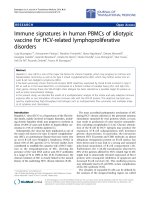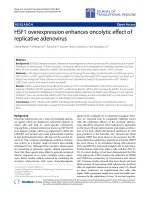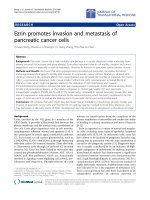Báo cáo hóa học: " Strain-induced high ferromagnetic transition temperature of MnAs epilayer grown on GaAs (110)" pptx
Bạn đang xem bản rút gọn của tài liệu. Xem và tải ngay bản đầy đủ của tài liệu tại đây (2.14 MB, 7 trang )
NANO EXPRESS Open Access
Strain-induced high ferromagnetic transition
temperature of MnAs epilayer grown on
GaAs (110)
Pengfa Xu
1
, Jun Lu
1
, Lin Chen
1
, Shuai Yan
1
, Haijuan Meng
1
, Guoqiang Pan
2
, Jianhua Zhao
1*
Abstract
MnAs films are grown on GaAs surfaces by molecular beam epitaxy. Specular and grazing incidence X-ray
diffractions are used to study the influence of different strain states of MnAs/GaAs (110) and MnAs/GaAs (001) on
the first-order magnetostructural phase transition. It comes out that the first-order magnetostructural phase
transition temperature T
t
, at which the remnant magnetization becomes zero, is strongly affected by the strain
constraint from different oriented GaAs substrates. Our results show an elevated T
t
of 350 K for MnAs films grown
on GaAs (110) surface, which is attributed to the effect of strain constraint from different directions.
PACS: 68.35.Rh, 61.50.Ks, 81.15.Hi, 07.85.Qe
Introduction
Today, there is growing interest for realization of new
technologies utilizing spin degree of freedom of elec-
trons in semiconductor devices [1]. The technology of
manipulating spin in semiconductors promises devices
with enhanced functionality and higher speed. A prere-
quisite for realization of such kind of devices is develop-
ment of solid-state spin injectors at room temperature.
Diluted magnetic semiconductors (DMSs) and ferromag-
net/semiconductor hybrids are two important compo-
nents for efficient spin injection. The exploitation of
DMSs, howev er, is severely hindered by their low Curie
temperature due to the low solubility of transition
metals in semiconductors [2,3]. With room-temperat ure
ferromagnetism and high crystal quality, MnAs has been
epitaxied on (001)-, (110)-, (111)-, and (113)-oriented
GaAs substrates [4-9]. Moreover, MnAs/GaAs having
sharper interface than that of Fe/GaAs has been pre-
sented [10,11]; the sharp interface is considered to be
crucial for obtaining higher transmission efficiencies.
Recently, spin injection from MnAs into GaAs has been
demonstrated [12], and the spin-dependent tunneling
experiments show that the spin polarization at MnAs/
GaAs interfaces is high [13,14]. Therefore, MnAs/GaAs
hybrid is attracting more and more attention for its
potential applications in spin injection, magnetic tunnel-
ing junctions, and magnetically logic devices.
The first-order magnetostructural phase transition is a
long-standing topic in magnetism [15-20]. Bulk MnAs
shows a coupled first-order magnetostructural phase
transition from the ferromagnetic hexagonal a-phase
(P6(3)/m mc) to the paramagnetic orthorhombic b-phase
(Pnma) which is contracted in volume by 2% at about
318 K. For epitaxial MnAs films on GaAs substrate, the
transition proceeds continuously over a broad tempera-
ture range with coexistence of the two phases. The
phase coexistence results in a considerable fraction of
MnAs epitaxial films which are usually in paramagnetic
phase at ~30°C, a strong limitation for room tempera-
ture spintronic devices. The first-order magnetostruc-
tural phase transition temperature T
t
,atwhichthe
remnant magnetization becomes zero, can be enhanced
either by applying an external magnetic field or by
growing MnAs films on different oriented GaAs sub-
strates [21]. F or example, T
t
forMnAsfilmsgrownon
GaAs (111)B is higher than that grown on GaAs (001)
[18,22,23].
Epitaxial MnAs films on GaAs (001) and GaAs (111)B
have been thoroughly investigated [4-6], while little
attention has been paid to MnAs films grown on GaAs
(110) [7]. The spin relaxation time is considered crucial
* Correspondence:
1
State Key Laboratory for Superlattices and Microstructures, Institute of
Semiconductors, Chinese Academy of Sciences, P.O. Box 912, Beijing 100083,
China
Full list of author information is available at the end of the article
Xu et al. Nanoscale Research Letters 2011, 6:125
/>© 2011 Xu et al; licensee Springer. This is an Open Access article distributed under the terms of the Creative Commons Attribution
License (http://creativecommons .org/license s/by/2.0), which permits unrestricted use, distribution, and reproduction in any medium,
provided the original work is properly cited.
important for practical application of spin memory
devices or spin quantum computers. In GaAs (110)
quantum wells, the spin relaxation time is in nanose-
cond range, much longer than that in GaAs (001) where
the spin relaxation time is in picoseconds range [7].
More work is expected for investigation of MnAs films
grown on GaAs (110) surfaces. In this work, we will pre-
sent that epitaxial MnAs films grown on GaAs (110) are
with a different strain states fr om MnAs films grown on
GaAs (001), and a-phase can coexist with b-phase to a
higher temperature (remnant magnetizatio n becomes
zero when the temperature reaches 350 K).
Experimental procedure
TheMnAsfilmsweregrownonGaAs(110)andGaAs
(001) substrates by molecular beam epitaxy with a 12-
keV reflection high-energy electron diffraction (RHEED)
to monitor the growth process. Before growth of MnAs,
a 100-nm GaAs buffer layer was grown to smoothen the
surface. For MnAs films grown on GaAs (110), the buffer
layer was grown at a lower substrate temperature T
s
=
400°C and higher As
4
/Ga beam equivalent pressure (BEP)
ratio of 50, while for the buffer layer grown on GaAs
(001), a s tandard procedure (T
S
= 560°C, As
4
/Ga = 12)
was used. The growth parameters and thickness of
MnAs films on GaAs (110) and GaAs (001) are shown in
Table1.DuringMnAsgrowth,thesurfaceis(1×2)
reconstructed. By analyzing RHEED patterns taken during
growth of MnAs, we get the following epitaxial relation-
ship:
()110 0
MnAs//(110) GaAs, [0001] MnAs//[001]
GaAs, and
()1120
MnAs//
[]110
GaAs. The streaky
RHEED pattern becomes sharper after in situ cooling the
sample from growth temperature to room temperature,
indicating enhancement of crystal quality. The micro-
structure and interface of the MnAs films were character-
ized by high-resolution cross-sectional transmission
electron microscopy (HRTEM), while t he study of the
magnetic domain structures was carried out by using
magnetic force microscope (MFM). By using tapping/lift
modes, the topographic and magnetic forc e images may
be collected separately and simultaneously in the same
area of the sample. The magnetic property of all the sam-
ples was measured by superconducting quantum interfer-
ence device magnetometry with magnetic field parallel to
the surface of samples. Anisotropic strain of the thin
MnAs films was characterized by X-ray diffraction
(XRD). The XRD experiments were performed at the
U7B beam line of National Synchrotron Radiation
Laboratory of China using a 0.154-nm wavelength mono-
chromatic beam, which is selected through a double-
crystal Si (111) monochromator, and triple-axis mode
was used in these measurements in order to achieve high
resolution. Strain information was obtained through mea-
surements of in-plane and out-of-plane diffractions in the
ω/2θ scan mode. Specially, grazing incidence geometry
was performed for in-plane measurements (IP-GIXD).
Results and discussion
Atomic force microscopy (AFM) and MFM images
taken from the growth surface are shown in Figure 1.
OnecanseefromFigure1thatthereisnoevident
stripe pattern in AFM images. Generally, all the samples
in this study a re very thin, and the stripe height is
roughly 1% of the film thickness. As shown in Figure 1,
the magnetic domains are randomly distributed in MFM
images for MnAs films grown on both GaAs (110) and
GaAs (001). We also observed the cross-sectional MFM
images for MnAs/GaAs (001) and MnAs/GaAs (110).
Although we can see sharp interfaces between MnAs
and GaAs from Figure 2a,b, we cannot see evident bor-
ders between ferromagnetic a-phase and paramagnetic
b-phase, indicating that the two phases are mixing
together. Our results are different from observations in
a 200-nm MnAs film epitaxied on GaAs (001) presented
in [24], in which ferromagnetic a-phase and paramag-
net ic b-phase are obviously separated. We assumed this
phenomenon resulted from the too thin thickness of
MnAs layer. Figure 3 shows the HRTEM image of sam-
ple D, MnAs/GaAs (110), from which we can observe
that MnAs films have a well-ordered crystal orientation
and a sharp interface between MnAs and GaAs. Judged
from the chromatic aberration of MnAs and GaAs sub-
strate, the thickness of the epitaxial MnAs film is 11 nm.
The remnant magnetization M
r
as a function of tem-
perature T is plotted in Figure 4a. The linear decrease
of M
r
at low temperature is caused by thermal fluctua-
tion, while the rapid decreasing at high temperature is
caused by structur al transition from hexagonal phase to
orthorhombic phase. As the thickness can change mag-
netic property of MnAs epilayer [7,25], M
r
becomes
zero when the temperature reaches 340 and 350 K for
samples B and sample D, respectively. In accordance
Table 1 Growth parameters and the thickness for samples A-D
Sample Growth temperature (°C) As
4
/Mn BEP ratio Furnace cooling Thickness (nm) GaAs substrate
A 230 300 N 11 GaAs (001)
B 210 175 N 3 GaAs (110)
C 210 300 N 11 GaAs (110)
D 210 175 Y 11 GaAs (110)
Xu et al. Nanoscale Research Letters 2011, 6:125
/>Page 2 of 7
with RHEED pattern analysis given above, M
r
exceeds
1,200 emu/cm
3
at 5 K for sample D, which is a bit lar-
ger than the saturation magnetization reported for
MnAs/GaAs (001) at 10 K with little crystal defect and
optimum intra- and inter-stri pe magnetic coupling [26].
The remarkable magnetic property difference between
sample C and sample D may originate from the different
growth conditions, such as the low substrate tempera-
ture and over pressure of As
4
for sample C, or different
stoichiometry. Figure 4b shows M-H hysteresis loops
measured at room temperat ure with magnetic field
applied along the direction of MnAs
()1120
, the easy
axis of magnetization. The magnetization hysteresis
loops show a perfect square form for all the samples
studied here.
In order to probe the effect of anisotropic strain on
the first-order magnetostructural phase transition, we
performed synchrotron XRD measurements. The experi-
mental results are shown in Figure 5. The orthorhombi c
notation is used for the a-phase lattice parameters, in
which a
ortho
, b
ortho
,andc
ortho
stand for the spacing
between MnAs (0001), MnAs
()1120
,andMnAs
()110 0
, respectively. The lattice parameters, primitive
cell volume, and transition temperature are shown in
Table 2. Early in the 1960s, Bean and Rodbell and
Menyuk et al. concluded that T
t
is proportional to the
Figure 1 Images of room-temperature AFM and MFM.Room-temperatureAFM(upperpanel)and MFM (lower panel) images for 11-nm
MnAs films grown on GaAs (110) (left) and GaAs (001) (right), taken from the growth surface.
Xu et al. Nanoscale Research Letters 2011, 6:125
/>Page 3 of 7
Figure 2 Cross-sectional MFM images for (a) MnAs/GaAs (110) and (b) MnAs/GaAs (001).
Figure 3 HRTEM image of sample D (MnAs/GaAs (11 0)). The crystallographic directions of t he epitaxial film were indicated with white
arrows.
Xu et al. Nanoscale Research Letters 2011, 6:125
/>Page 4 of 7
Figure 4 Temperature dependence and magnetic field dependence of magnetization. a Temperature d ependence of the remnant
magnetization M
r
for samples A-D. M
r
remains over zero even when the temperature reaches 340 and 350 K for samples B and D, respectively.
b The magnetic field dependence of magnetization for MnAs grown on GaAs (110) and GaAs (001) at 300 K, under a magnetic field applied
along the easy axis of magnetization.
Xu et al. Nanoscale Research Letters 2011, 6:125
/>Page 5 of 7
primitive cell volume and a larger primitive cell volume
(V)correspondstoahigherT
t
based on the magnetos-
trictive model [15, 16]. Clearly our experimental results
cannot be explained by a simple effect of primitive cell
volume variation, and T
t
is not a linear function of V.
For example, as to all the epitaxial films studied here,
the primitive cell volume is smaller than that of the
bulk material, while ferromagnetic hexagonal a-phase
can coexist with paramagnetic orthorhombic b-phase to
a higher temperature. F urthermore, there is remarkable
difference between lattice parameters for MnAs films
grown on GaAs (001) and GaAs (110). For sample A,
grownonGaAs(001),a
ortho
is larger, while b
ortho
and
c
ortho
are smaller than that for sample D, grown on
GaAs (110). In good agreement with the experimental
and theoretical results of Iikawa et al. [23], all these
changes result in a lower tra nsition temperature
(stretching of the lattice parameters in the basal plane
results in a higher T
t
, while stretching of lattice para-
meters along the perpendicular direction lowers T
t
).
Summary
In summary, we have shown that the ferromagnetic
order in MnAs can be extended to higher temperature
by growing MnAs on GaAs (110). Ferromagnetic
Figure 5 XRD patterns. XRD patterns measured by synchrotron radiation for reflections of MnAs
()110 0
in the specular geometry,
()1120
and (0002) in the grazing incidence geometry for samples A (black), B (blue), C (wine), and D (red). The radial scan along MnAs (0002) of sample
C can be fitted well by two peaks centered at 31.44 and 31.61 which can be ascribed to MnAs (0002) and GaAs (002), respectively (d).
Table 2 Lattice parameters, primitive cell volume, and
transition temperature of samples A-D and MnAs bulk
[27]
MnAs bulk Sample A Sample B Sample C Sample D
a (Å) 5.71 5.78 5.71 5.67 5.69
b (Å) 3.72 3.69 3.73 3.72 3.72
c (Å) 6.45 6.41 6.43 6.45 6.45
T
t
(Å) 313 325 335 350 350
V (Å
3
) 137.06 136.71 136.95 136.05 136.53
The lattice parameters shown in boldface were calculated from elastic
constant tensor of MnAs.
Xu et al. Nanoscale Research Letters 2011, 6:125
/>Page 6 of 7
a-pha se can coexist with paramagnetic b-phase to 350
K. By XRD measurements, it is found that T
t
is not a
simple function of primitive cell volume, and stretching
of lattice parameters in the basal plane or compressing
of lattice parameter in the perpendicular direction
results in a higher T
t
. The result described here attests
to a strong link between anisotropic strain and epilayer
properties. Understanding and mastering these charac-
terizations may open a possibility to control magnetic
properties via selection of substrate orientation and pro-
vide new possibilitie s for using MnAs epilayer in spin-
tronic devices.
Acknowledgements
This work was supported in part by the National Natural Science Foundation
of China under Grant No. 60836002 and the special funds for the Major
State Basic Research Contract No. 2007CB924903 of China and the
Knowledge Innovation Program Project of Chinese Academy of Sciences No.
KJCX2.YW.W09-1.
Author details
1
State Key Laboratory for Superlattices and Microstructures, Institute of
Semiconductors, Chinese Academy of Sciences, P.O. Box 912, Beijing 100083,
China
2
National Synchrotron Radiation Laboratory, University of Science and
Technology of China, Hefei 230029, China
Authors’ contributions
PX, JL, LC, SY, HM carried out the sample preparation. PX, JL and GP
participated in the XRD Measurements. PX carried out the MFM and SQUID
measurements, the statistical analysis and drafted the manuscript. JZ
conceived of the study and participated in its design and coordination. All
authors read and approved the final manuscript.
Competing interests
The authors declare that they have no competing interests.
Received: 12 August 2010 Accepted: 9 February 2011
Published: 9 February 2011
References
1. Zhao YJ, Geng WT, Freeman AJ: Structural, electronic, and magnetic
properties of α- and β-MnAs: LDA and GGA investigations. Phys Rev B
2002, 65:113202.
2. Bonanni A: Ferromagnetic nitride-based semiconductors doped with
transition metals and rare earths. Semicond Sci Technol 2007, 22:R41.
3. Bonanni A, Simbrunner C, Wegscheider M, Przybylinska H, Wolos A, Sitter H,
Jantsch W: Doping of GaN with Fe and Mg for spintronics applications.
Phys Stat Sol (b) 2006, 243:1701.
4. Schippan F, Trampert A, Däweritz L, Ploog KH, Dennis B, Neumann KU,
Ziebeck KRA: Microstructure formation during MnAs growth on GaAs(0 0
1). J Cryst Growth 2000, 201/202:674.
5. Tanaka M, Saito K, Nishinaga T: Epitaxial MnAs/GaAs/MnAs trilayer
magnetic heterostructures. Appl Phys Lett 1999, 74:64.
6. Däweritz L, Kästner M, Hesjedal T, Plake T, Jenichen B, Ploog KH: Structural
and magnetic order in MnAs films grown by molecular beam epitaxy on
GaAs for spin injection. J Cryst Growth 2003, 251:297.
7. Kolovos-Vellianitis D, Herrmann C, Däweritz L, Ploog KH: Structural and
magnetic properties of epitaxially grown MnAs films on GaAs(110). Appl
Phys Lett 2005, 87:092505.
8. Akinaga H, Miyanishi S, Tanaka K, Van Roy W, Onodera K: Magneto-optical
properties and the potential application of GaAs with magnetic MnAs
nanoclusters. Appl Phys Lett 2000, 76:97.
9. Akinaga H, De Boeck J, Borghs G, Miyanishi S, Asamitsu A, Van Roy W,
Tomioka Y, Kuo LH: Negative magnetoresistance in GaAs with magnetic
MnAs nanoclusters. Appl Phys Lett 1998, 72:3368.
10. Schippan F, Trampert A, Däweritz L, Ploog KH: Kinetics of MnAs growth on
GaAs(001) and interface structure. J Vac Sci Technol B 1999, 17:1716.
11. Lu J, Meng HJ, Deng JJ, Xu PF, Chen L, Zhao JH, Jia QJ: Strain and
magnetic anisotropy of as-grown and annealed Fe films on c(4 × 4)
reconstructed GaAs (001) surface. J Appl Phys 2009, 106:013911.
12. Stephens J, Berezovsky J, McGuire JP, Sham LJ, Gossard AC, Awschalom DD:
Spin accumulation in forward-biased MnAs/GaAs schottky diodes. Phys
Rev Lett 2004, 93:097602.
13. Garcia V, Jaffrès H, Eddrief M, Marangolo M, Etgens VH, George JM:
Resonant tunneling magnetoresistance in MnAs/III-V/MnAs junctions.
Phys Rev B 2005, 72:081303(R).
14. Garcia V, Jaffrès H, George JM, Marangolo M, Eddrief M, Etgens VH:
Spectroscopic measurement of spin-dependent resonant tunneling
through a 3D disorder: The case of MnAs/GaAs/MnAs junctions. Phys Rev
Lett 2006, 97:246802.
15. Bean CP, Rodbell DS: Magnetic disorder as a first-order phase
transformation. Phys Rev 1962, 126:104.
16. Menyuk N, Kafalas JA, Dwight K, Goodenough JB: Effects of pressure on
the magnetic properties of MnAs. Phys Rev 1969, 177:942.
17. Zhao YJ, Zunger A: Zinc-blende half-metallic ferromagnets are rarely
stabilized by coherent epitaxy. Phys Rev B 2005, 71:132403.
18. Garcia V, Sidis Y, Marangolo M, Vidal F, Eddrief M, Bourges P, Maccherozzi F,
Ott F, Panaccione G, Etgens VH: Biaxial strain in the hexagonal plane of
MnAs thin films: The key to stabilize ferromagnetism to higher
temperature. Phys Rev Lett 2007, 99:117205.
19. Jenichen B, Kaganer VM, Kästner M, Herrmann C, Däweritz L, Ploog KH,
Darowski N, Zizak I: Structural and magnetic phase transition in MnAs
(0001)/GaAs(111) epitaxial films. Phys Rev B 2003, 68:132301.
20. Kaganer VM, Jenichen B, Schippan F, Braun W, Däweritz L, Ploog KH: Strain-
mediated phase coexistence in MnAs heteroepitaxial films on GaAs: An
x-ray diffraction study. Phys Rev B 2002, 66:045305.
21. Ney A, Hesjedal T, Däweritz L, Koch R, Ploog KH: Extending the magnetic
order of MnAs films on GaAs to higher temperatures. J Magn Magn
Mater 2004, 288:173.
22. Das AK, Pampuch C, Ney A, Hesjedal T, Däweritz L, Koch R, Ploog KH:
Ferromagnetism of MnAs studied by heteroepitaxial films on GaAs(001).
Phys Rev Lett 2003, 91:087203.
23. Iikawa F, Brasil MJSP, Adriano C, Couto ODD, Giles C, Santos PV, Däweritz L,
Rungger I, Sanvito S: Lattice distortion effects on the magnetostructural
phase transition of MnAs. Phys Rev Lett 2005, 95:077203.
24. Rache Salles B, Marangolo M, David C, Girard JC: Cross-sectional magnetic
force microscopy of MnAs/GaAs(001). Appl Phys Lett 2010, 96:052510.
25. Däweritz L, Wan L, Jenichen B, Herrmann C, Mohanty J, Trampert A,
Ploog KH: Thickness dependence of the magnetic properties of MnAs
films on GaAs(001) and GaAs(113)A: Role of a natural array of
ferromagnetic stripes. J Appl Phys 2004, 96:5056.
26. Berry JJ, Potashnik SJ, Chun SH, Ku KC, Schiffer P, Samarth N: Two-carrier
transport in epitaxially grown MnAs. Phys Rev B 2001, 64:052408.
27. Willis BTM, Rooksby HP: Magnetic transitions and structural changes in
hexagonal manganese compounds. Proc Phys Soc Sect B 1954, 67
:290.
doi:10.1186/1556-276X-6-125
Cite this article as: Xu et al.: Strain-induced high ferromagnetic
transition temperature of MnAs epilayer grown on GaAs (110).
Nanoscale Research Letters 2011 6:125.
Submit your manuscript to a
journal and benefi t from:
7 Convenient online submission
7 Rigorous peer review
7 Immediate publication on acceptance
7 Open access: articles freely available online
7 High visibility within the fi eld
7 Retaining the copyright to your article
Submit your next manuscript at 7 springeropen.com
Xu et al. Nanoscale Research Letters 2011, 6:125
/>Page 7 of 7


